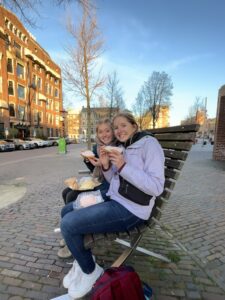Spain is extremely accessible to Europe and a very affordable country to travel in. So, while living abroad, it’s important to take advantage of this and travel! There are endless options to travel from Sevilla whether it be bus, train, or plane. During my time in Sevilla in spring of 2023, I visited 14 countries and at least 8 cities within Spain. With adequate planning and resourcefulness, it is possible to maximize a semester abroad and travel as a student!
Before you even get to Spain, I highly recommend planning out what your dream destinations are and when you want to make them a reality. Long weekends or full breaks are opportunities to go further away or to visit multiple cities in the same region. Weekends are better for staying within Spain, Portugal, or France so not as much of your trip is spent getting to your destination. Obtaining a general idea of when you want to go certain places helps when researching your travel options. An important fact to remember is that the sooner you book, the cheaper it’s going to be. Flight prices in Europe will fluctuate 10-50 euros by the day, but the prices will continue to increase as the day of travel approaches. This means, if you find a flight that works with your plans, you could always wait a couple days to see if the price goes down, but don’t wait for long. Bus and train prices rarely vary, they only will increase while approaching the day of travel. This is consistent with sleeping arrangements as well (AirBnb or hostels). Note: on Google Flights, you can see price history and if the price you’re seeing is lower or higher than usual.
While planning your trip, be flexible! If you are still figuring out where you want to go and when, then look at other options before committing to one and see what’s going to generally be cheaper. I love using Google flights and pulling up “Sevilla to anywhere” with certain dates and looking at the options.
Another part of being flexible is evaluating all your travel options. Use Google Flights, Omio, Hostel World, and AirBnb to look at:
- One-way flights
- Surrounding airports
- Trains (within Spain or to Portugal)
- Busses (within Spain or to Portugal)
- AirBnb vs hostel
With all these options, it’s important to do a cost-benefit analysis of what convenience is worth to you. For example, I usually prefer direct flights, which Ryanair offers. However, Iberia Airlines offered Sevilla to Barcelona flights with a short stop in Madrid which departed later Friday afternoon. Taking this flight meant that we didn’t have to miss class on Friday and could stay later in the afternoon on Sunday, so we were able to maximize our time in Barcelona. For Paris, we found it was significantly cheaper to book two separate one-way tickets that arrived at one airport and departed from another. The point is to take time while planning and evaluate all your options.
Once you get to your destination, any research you’ve done will hopefully benefit you! I always recommend keeping a general itinerary of what you’re doing, when, and how long it takes to get to a certain place (use Google Maps for this in advance by looking at walking or public transit).
Also, I’d recommend keeping your experience culturally centered! How else can you fully experience the place you’re visiting without eating authentic food or visiting historical sites? Eating local is usually a cheaper option when eating out. The exception to this is Switzerland or Copenhagen (Denmark) where even the cheapest options are still pricy. But when in doubt, go to a grocery store. You can get fresh bread, meat, and cheese for cheap or if you have time or the means to cook, pasta with red sauce is always a safe, affordable option. 😉
While figuring out things to do, there are usually a couple landmark experiences that are “must-do’s” for visiting that city. Typically, these are cultural immersion experiences that encompass some historical importance of the city. Keep in mind that these are not always the most budget friendly activity options, but most of the time they’re worth it. I found it was valuable to splurge on the experiences that seemed interesting enough to make our experience the fullest it could be. Another great way to get to know a city is free walking tours! These tours can be reserved online, days or weeks before your trip that come at no charge to you other than tipping your guide at the end of the tour. It’s helpful to do these at the beginning of your trip to help get acquainted with the layout and the general history of the city. I highly recommend if you want to get to know a city and are interested in its overarching history!
While I highlighted many of the important aspects of planning a budget-friendly trip, here are some more general tips/considerations as you plan your adventure.
AirBnb: Europe is notorious for the “hostel experience” being a budget-friendly option for sleeping arrangements. However, you usually pay per bed per night in hostels so when traveling in a group, I found that it’s cheaper and generally more comfortable to stay in an AirBnb. Some instances when I did get a hostel were when I traveled solo (hostels are usually conveniently located in a city center), emergency situations (last-minute needing a place to sleep), and even once when I was traveling in a group of 7 (so we took up over half of the shared dorm room).
How to find a good AirBnb: the biggest part of finding an AirBnb is location! Use the “filters” tab at the top to narrow down price point and see in what price range most of your options are. Use the map feature to see where they are in relation to the city center. It is usually way more convenient to stay in the city center, but sometimes it’s worth it to save some money and take public transport in and out of the city for the day. When evaluating specific AirBnb’s, look at reviews of the property and host. Also look at the exact spot on the map and make sure it’s close enough to a bus stop/metro station or to the city center by walking. Sometimes, the listings will say “close to X bus line” but it’s always good to verify that.
Public transportation: public transportation is your friend! Google Maps shows you all the public transit options to get from one place to another. Use it! I recommend trying to figure out how many times you’re going to use public transport in a city and see if it’s worth it to get a 24-hour (or longer) unlimited card or instead just buy a certain number of trips. Most cities have this as an option. Keep in mind that many times airport transportation to/from is not included in these 24 hour passes and will cost more than regular public transit (however, still usually the cheapest way to get from an airport into the city).
Be organized: If you decide to travel a lot, make sure to keep all your bookings and receipts organized! I did this by creating folders in my email for each trip and making a Google Doc with links and itinerary to share with my travel group.
Random: Keep in mind when looking at flights that they don’t get delayed as often as they do in the United States. Also, if you see a short layover (30-60mins), the airline wouldn’t offer it if the flight wasn’t possible to make! Hopefully this gives you peace of mind.
In conclusion, traveling in Europe is very safe, easy, and reliable. It’s truly a priceless experience to adventure and experience the richness of what Spain and its surrounding countries have to offer.
¡Buen viaje!
Corrinne










